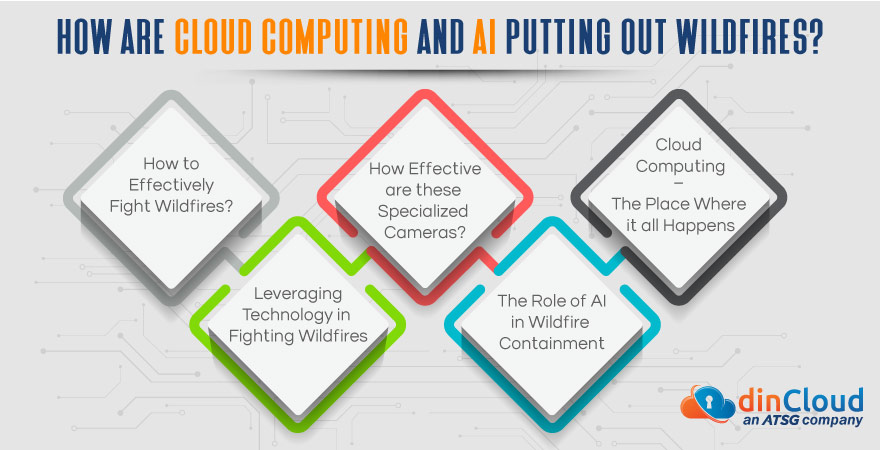For the past many years now, there are a number of people including experts that have downplayed the notion of Climate Change. However, we have started witnessing the true after effects of climate change across the globe.
One of those effects is Wildfires, which are a great and emerging threat for human life, property and invaluable forests. Forests, especially the natural ones, do not grow overnight. They are also home to a whole ecosystem, comprising many animal and plant species.
Wildfires can potentially devastate these natural and national resources in a matter of a few hours or days. According to the United Nations (UN), the risk of fires is drastically on the rise across the globe, estimated to rise by 50% by the end of this century.

Related: 10 Compelling Reasons SMBs Need Cloud Computing
How to Effectively Fight Wildfires?
Well, any wildfire is in fact a race against time. The more timely it can be detected, the better chances authorities have in both containing such fires, and putting them out before they annihilate vast swathes of precious forest lands along their way.
Historically, the United States has been a very active region when it comes to wildfires. The state of California, in particular, has recorded some of the largest and most devastating fires over the past few years.
The US state of California witnessed its worst wildfire in recorded history, back in the year 2020. An estimated 4% of the state’s total forested land was reduced to ashes. Napa County was the worst hit within California, whose 40% forest land was burnt.
Leveraging Technology in Fighting Wildfires
Across the globe, multispectral optical imaging technologies are being leveraged to provide the “watchful” set of eyes across large expanses of forest lands. These specialized cameras, equipped with the latest imaging technologies, are proving a game changer.
These state of the art imaging cameras are being installed not only in USA, but across the globe. These cameras are installed at strategically high locations, mostly hilltops, to maximize their range, effectiveness and coverage area.
These specialized cameras are capable of rotation, further maximizing the area they can cover. These cameras are equipped with specialized sensors that scan the countryside in color, monochrome and infrared modes to generate broad spectrum data.
Related: 10 Frequently Asked Questions (FAQs) about Cloud Computing
How Effective are these Specialized Cameras?
Some of the highly advanced fire sensing cameras are effective for as much as a whopping 40 mile radius, under the ideal operating conditions. These are no match for manual observation, as it is both costly and time consuming, with other limitations as well.
Before wildfires transform into a full-blown disaster, there are certain telltale signs, and these specialized cameras are fully capable of detecting those signs. The most common signs include a typical heat and smoke signature.
If this heat and smoke signature can be detected in time, and the relevant authorities are alerted in a timely manner, it is way easier to both contain and put out such fires. Early detection also helps a great deal in the rescue and rehabilitation of the nearby residents.
Related: Cloud Computing Business Applications and Implementations
The Role of AI in Wildfire Containment
The highly intelligent and specialized cameras that we discussed above are generating vast amounts of data every day. When it comes to analyzing the cause of wildfires, there can be multiple factors at play, such as humidity, temperature and altitude etc.
So, this is where Artificial Intelligence (AI) comes into the picture. The real-time data about the forest atmosphere that these specialized cameras generate is compared with the historical data for the same and other similar regions, for the corresponding season.
The historical data acts as a reliable and accurate benchmark for specialized AI algorithms that are capable of identifying any major deviation from the past / historical trends. So, a combination of visual and historical data goes a long way in preventing and stopping fires.
Cloud Computing – The Place Where it all Happens
So, where does Cloud Computing fit into this whole picture? Well, the Cloud acts as the repository for all the historical and real-time data about forests that is being generated by the specialized cameras and sensors we have discussed above.
That is not all, the immense processing muscle of the Cloud is used to train and refine AI algorithms that actually go on to detect anomalies in the various data points. This in turn results in generating the potential “flashpoints” which need to be closely monitored.
Lastly, the Cloud also facilitates correlating the data of one region with that of another, due to the ease of data mobility and accessibility it has to offer. This capability comes in really handy for the lower income countries that also want to preserve their forests.
Related: Cloud Computing; A Savior Among the Covid-19 Crisis
Conclusion
Forests are one of the many other natural resources that are depleting at astronomical rates. We need to preserve forests and the ecosystems they support not only for us, but also for our coming generations.
It is leading technologies like Cloud Computing, Artificial Intelligence (AI) and Multi-Spectral imaging that are making this seemingly impossible task a whole lot easier and cost efficient. Still, there are many new frontiers to be conquered within these fields.
Contact dinCloud, an ATSG company, for your data processing and storage needs in highly secure and scalable Cloud Computing environments.


